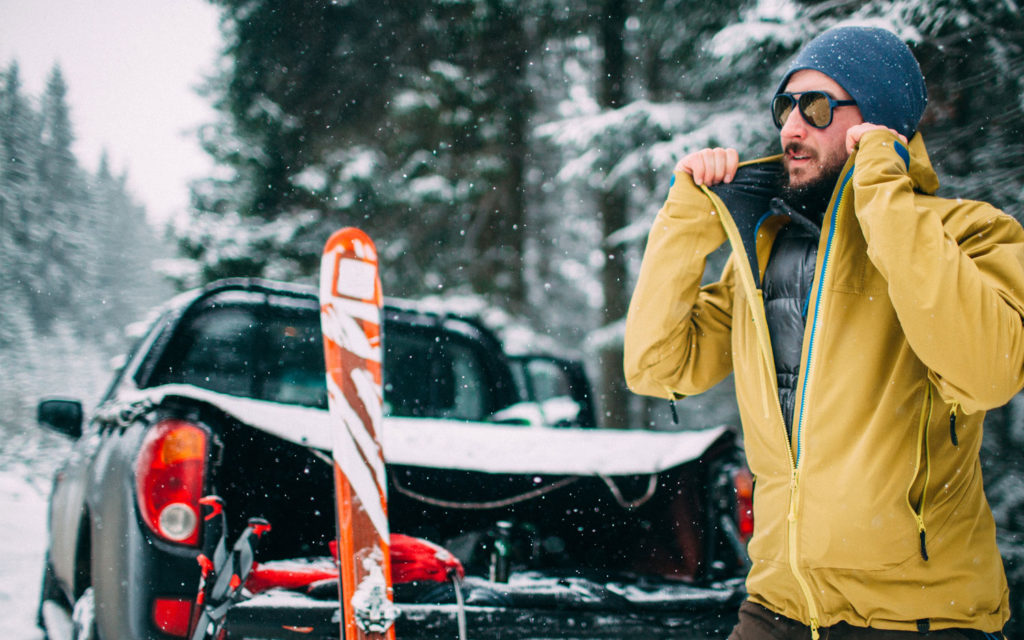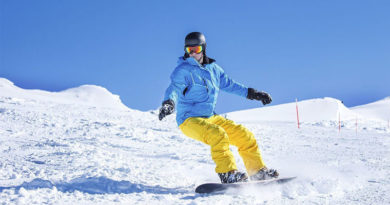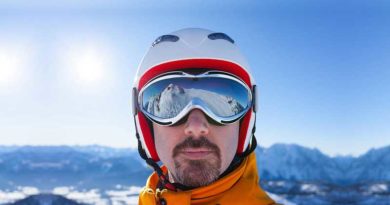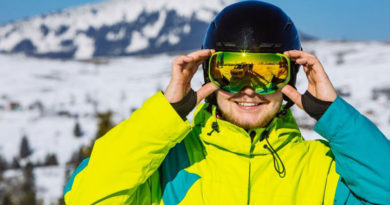Best Budget Ski Base Layers of 2022-23
The fundamental function of a ski base layer is to wick moisture away from the body. The body remains dry which is essential to regulate the core body temperature. Base layers, then, are as important as the ski jacket you wear to keep yourself warm. You should avoid fabrics like denim and cotton and opt for fabrics that provide warmth and dry quickly if they get wet. Merino wool and polyester are the most common choices for base layer fabrics. This guide will inform you about the features each of these base layers have to offer. The guide will help you make a better decision in choosing a budget base layer.
So here is the list of the top budget-friendly ski base layers if you are looking for one.
1. Helly Hansen Lifa Stripe Crew

Material: 100% LIFA Polypropylene
Weight: 4.4 oz.
Fabric Weight: 125 g/m2
Category: Lightweight
Helly Hansen Lifa Stripe Crew is a budget base layer and it falls in the lightweight category which makes it ideal for high-output activities like skiing and winter hiking. Being lightweight, it provides some insulation but requires a mid-layer or an insulating shell. The fabric is synthetic. But instead of polyester – which is a more common synthetic fabric – The Lifa Stripe Crew is made from polypropylene. Polypropylene is much better at wicking moisture, like sweat, from the body than polyester and nylon. Better moisture-wicking properties mean better breathability. The breathability is exceptional which keeps you from overheating during exertion. The drying time of Lifa Stripe is exceptional which prevents you from getting cold when you sweat.
But budget means compromise. The downside of polypropylene is that isn’t as warm as the other fabrics. You would have to add layers to achieve the desired warmth in cold conditions. Thin also means a compromise on durability. But considering how thin it is, the durability and the warmth are still admirable. Lifa Stripe Crew has an unbeatable price for the performance that it delivers. However, if you are looking for some extra performance, Helly Hansen also offers the Midweight Lifa Merino Crew. The Merino Crew has a merino exterior with polypropylene lining. Of course, it will cost you some extra bucks.
What I like: Excellent breathability, dries quickly, wicks moisture well, lightweight
What I don’t like: Not super warm, requires a mid-layer
2. REI Co-op Merino 185
Material: RWS Merino Wool
Weight: Not specified
Fabric Weight: 185 g/m2
Category: Midweight
Merino 185 is REI’s in-house product. It is among the all-time favorite merino baselayers for winter activities. It isn’t the cheapest, but it is versatile and can be used for cross-country skiing and other activities in the snow. You can consider it as the jack of all trades, master of none. It is a competitive option in the market and checks all the boxes.
It is soft, has a good amount of stretch, and has effective moisture-wicking. Tapered sleeves add to comfort. The addition of a zipper enhances ease of use. The quality surprisingly competes with brands specializing in wool layerings like Icebreaker and Smartwool.
Merino 185 is an update to the merino midweight which itself is fantastic. Merino 185 is thinner than the midweight which also means it is less warm than the midweight. But a solid performer nevertheless. However, some people would still complain that it isn’t cheap for what it offers from a brand like REI.
But then again, merino wool tops don’t come cheap.
What I like: Fabric feels soft against the skin, stretchy, and well made
What I don’t like: A little expensive for an REI product.
View Men’s at REI View Women’s at REI
3. Patagonia Capilene
Material: 100% Recycled Polyester
Weight: 6.2 oz.
Fabric Weight: 147 g/m2
Category: Midweight
Patagonia’s Capilene Midweight Crew has been around for a long time now. It is Patagonia’s best-selling base layer, and for solid reasons. It is a versatile top that can be used in a range of outdoor winter activities. Its versatility makes it a favorite among adventurers. It offers great features for its price. The low price is because it is a synthetic fabric. But what makes this fabric outstand among all the other synthetics on the list is that it is 100% recycled.
The top has a very lightweight and breathable design. The fabric is thin and easily transfers moisture from the body to open air. The fabric isn’t as warm as merino wool but it gets the job done. It can be worn on its own during mild weather, but you need to add layers during cold conditions. Even though the fabric is thin, it is still durable which is an advantage of being synthetic. The top can be used daily and looks new even after many washes. It is a great value top, one that will last you many seasons. On top of all that, it is a nice alternative for those allergic to merino wool.
What I like: Blocks wind well, durable, dry quickly
What I don’t like: Not super soft and warm
View at evo View at Backcountry
4. Icebreaker 200 Oasis
Material: 100% Merino Wool
Weight: 11.8 oz.
Fabric Weight: 200 g/m2
Category: Midweight
Icebreaker is a company that specializes in merino wool layering. The Icebreaker 200 Oasis is made of 100% merino wool. It has a typical snug fit that a base layer should have, which lets you move without feeling like you are trapped. It is a warm top. Of course, being merino, you should expect that. It is a good choice for cold weather. You can perform some high-output activities wearing the Oasis. One of the outstanding features of this base layer is that it is warm but doesn’t let you overheat. It feels almost magical and makes you wonder how it does that.
Another outstanding feature that sets the 200 Oasis is its durability. When compared to synthetic fabrics, merino wool is not much durable. But the 200 Oasis is a durable option for a merino base layer. It is a durable base layer when compared to its competition. It has a fairly durable weave with minimal itch adding to its comfort. The performance is consistent and dependable. It has a tight fit that makes it easy to add layers to it. Although it is a bit expensive, the versatility and durability that it provides justify the cost.
What I like: Versatile, odor-resistant, quick to dry, comfortable
What I don’t like: Average breathability due to dense weaves, heavy when wet
5. Smartwool Merino 250

Material: 100% Merino Wool
Weight: 10 oz.
Fabric Weight: 250 g/m2
Category: Midweight
Smartwool is another specialist in wool layering. Their merino wool base layers are quite the performers and Merino 250 is no exception. It is a well-known base layer. It has impressive thermoregulation, warmth, and breathability. Merino 250 is the thickest and warmest offering by Smartwool. Although Smartwool advertises it as a base layer, it is warm enough to be used as a mid-layer. Yet, it has an excellent fit that looks stylish. Flat-lock seams add to comfort. The slim fit gives a great shape to the body. Even the feel of the Merino 250 is high quality.
It is resistant to abrasion which is surprising for a merino wool base layer. When it comes to merino wool, durability isn’t the strongest feature. But the thickness of the Merino 250 makes it very durable. But an obvious problem arises with thickness; Merino 250 doesn’t dry out quickly. Thermoregulation is another outstanding point of the Merino 250. It keeps you warm but prevents you from overheating. The adaptability of this base layer to changing temperatures makes it a good choice for springtime ski touring. However, it is best to avoid using it in warm temperatures and look for lightweight alternatives.
What I like: Temperature regulation, good balance of warmth and breathability, extremely soft, available in both crew and ¼ zip
What I don’t like: Slow to air dry, requires care to last long, not the cheapest option
6. Under Armour ColdGear Mock T-shirt

Material: 87% Polyester/13% Elastane
Weight: 4.8 oz.
Fabric Weight: Not specified
Category: Lightweight
Under Armour is a reputable brand in the sports industry for its sportswear. Their ColdGear lineup is no exception. But that is not why the Compression Mock T-shirt is on this list. What puts the Compression Mock T-shirt on this list is its excellent performance for a reasonable price. The fabric is synthetic as you can expect at a low price. It is 83% polyester and 13% elastane. Compression Mock T-shirt has a dual-layer fabric with an inner brushed layer for comfort and an outer fast-drying layer. The fabric has a good moisture-wicking ability. It pulls away sweat and dries fast.
The fabric also has 4-way stretch construction. The construction allows excellent mobility in all directions making the Compression Mock T-shirt ideal for athletes. Under Armour is not joking about the compression as well. The top completely compresses the body becoming a second skin. If you aren’t used to such compression, you would feel uncomfortable in the beginning. A compression Mock T-shirt is a warm top that works best in a cold climate. You will overheat in the summer so do keep that in mind. There are some durability issues as well, particularly about the logo on the neck. It comes off after a few washes. But a little compromise is expected at this price point.
What I like: Stretchy fabric, feels comfortable, affordable
What I don’t like: Tight fit, runs small
7. REI Co-op Lightweight Base Layer
Material: 92% Polyester/8% Spandex
Weight: 6.5 oz.
Fabric Weight: Not specified
Category: Lightweight
REI Co-op Lightweight Base Layer Crew is another REI entry in this list. It is simple and performs its function well. The performance is also consistent with the price. So you get what you pay for. It is not as versatile as other base layers on this list but you should expect that at this price point. Of course, with a low price, there are some downsides. The fabric of this base layer is made of 92% polyester and 8% spandex. The blend of spandex offers stretch that prevents restriction in movement along with a comfortable and better fit. The comfort and stretch make it suitable for athletic activities.
However, it has a thicker cut which doesn’t allow it to breathe well. The moisture-wicking property is fairly good, not the best, but good. Despite being synthetic, it is slow to dry but the heat retention is outstanding for being a lightweight base layer. It competes with midweight wool tops in some cases, which is impressive. The thicker cut also makes it more durable and will last longer. It works best as it breaks in which happens as it gets washed every time after use. All-in-all, it is a good value base layer that scores well in many areas but lacks in some.
What I like: Simple, inexpensive yet functional
What I don’t like: Less durable, takes longer to dry
View Men’s at REI View Women’s at REI
8. Outdoor Research Echo L/S

Material: 100% Polyester
Weight: 3.8 oz.
Fabric Weight: 108 g/m2
Category: Lightweight
The Echo line from Outdoor Research has been designed for high-output activities in warm weather. It is a lightweight solution for skiing in the sun and it has a 100% polyester fabric, which is extremely lightweight. The Echo L/S is one of the best value base layers because of the performance you get for the price – unmatched breathability, durability, and mobility. It has a thicker build but it is still lightweight which does surprise you the first time you look at it. The thicker build makes it warm but warmth is where this base layer lacks. The proprietary AirVent fabric does help but it’s still not warm. It’s more suited for warmer climates but can be used as a technical base layer in cold conditions.
However, it is much more durable due to its thickness and because it is synthetic. The build feels solid and gives you confidence that it will last long. It is fast drying. A sweat collar at the top of the back avoids sweat from beading down on the back which is a neat feature. It has an athletic fit with thoughtful body mapping on the shirt that allows for a full range of motion even in layers.
What I like: Ultralight yet durable, UPF protection, thoughtful articulation
What I don’t like: Poor odor resistance, not built for super cold weather
View at Backcountry View at Amazon
Best Budget Ski Baselayers: Comparison Table
| BASELAYER | MATERIAL | WEIGHT | FABRIC WEIGHT | CATEGORY |
|---|---|---|---|---|
| Helly Hansen Lifa Stripe | LIFA Polypropylene | 4.4 oz. | 125 g/m2 | Lightweight |
| REI Co-op Merino 185 | RWS Merino Wool | Not specified | 185 g/m2 | Midweight |
| Patagonia Capilene | Recycled Polyester | 6.2 oz. | 147 g/m2 | Midweight |
| Icebreaker 200 Oasis | Merino Wool | 11.8 oz. | 200 g/m2 | Midweight |
| Smartwool Merino 250 | Merino Wool | 10 oz. | 250 g/m2 | Midweight |
| Under Armour ColdGear | Polyester/Elastane | 4.8 oz. | Not specified | Lightweight |
| REI Lightweight Baselayer | Polyester/Spandex | 6.5 oz. | Not specified | Lightweight |
| Outdoor Research Echo L/S | Polyester | 3.8 oz. | 108 g/m2 | Lightweight |
How to Choose a Baselayer for Skiing?

If you are reading this article, you are probably looking for a base layer for yourself. But what if you don’t want to rely on any list and want to choose a base layer on your own? What should you look for in a base layer for your skiing adventures?
Here are a few tips that will help you make a better decision for choosing a base layer.
Fabric Weight
Based on weight, base layers have three categories; lightweight, mid, and heavyweight. These are the most common categories among manufacturers. Weight refers to the insulation weight. This categorization helps you understand what to expect from your base layer.
You should choose a base layer according to the climate. Fabric weight and thickness are equal to warmth. As the weight and thickness go up, so does the price. But more weight and thickness means less moisture-wicking and less breathability.
Let’s look at the three categories.
- Lightweight base layers are good breathers. They get rid of moisture and dry quickly. However, they provide the least warmth. These base layers are a good choice for exerting activities and sports like ski touring, running, etc, where breathability is preferred to avoid overheating and stay dry. They are not made for cold conditions and require a mid-layer. They are thin and so least durable.
- Midweight base layers are the most versatile for the winter season. They keep you warm but they are still breathable during physical activities. Midweight base layers are ideal for resort skiers and those who aren’t working up a sweat. They can be worn as a first layer or a second warmer layer on a next-to-skin layer for desired warmth.
- Heavyweight base layers are especially for cold temperatures or non-demanding activities like winter walks around town or sitting around camp. They are bulky and they are the least versatile. Unless you use them in cold temperatures, you will overheat. They are usually used with lightweight layers for extra warmth. You need to evaluate if you need the added insulation of a heavyweight baselayer or not. Sometimes, using a combination of your would midweight layer can achieve the same amount of insulation.
Fabric Material
The majority of the fabric for base layers is made of merino wool or synthetic materials like polyester or polypropylene or a mix of the two. Base layer fabric pulls moisture away from the skin instead of absorbing it. The moisture from the skin is dispersed to the outer surface where it is evaporated.
These fabrics dry much faster than cotton reducing the risk of sudden swings in body temperature. All of these fabrics have their strengths and weaknesses which makes them ideal for different activities and weather conditions.
- Merino wool comes from sheep in Australia and New Zealand. It has moisture-wicking properties and at the same time, it feels soft and comfortable against the skin. Wool also has anti-microbial properties and it doesn’t stink after you sweat on it. It is great for multi-day use for its ability to stay smell-free. This fabric is also the best for warmth, however, it is not durable enough and does cost higher.
- Synthetic fabrics are made of polyester, polypropylene, or nylon. All of them have more or less similar properties. Polyester is the most common and cost-effective alternative to merino. Synthetic fabrics are breathable, moisture-wicking, and far more durable than merino wool. However, they don’t regulate the body as well as wool and so they have to be thick. Many brands offer a blend of wool and synthetic fabrics for effective heat regulation and increased durability.
The Right Fit
The right fit is essential for comfort – that is a no-brainer. But the right fit is also essential to optimize moisture-wicking and warmth. Your base layer should have a snug fit. Runners and skiers prefer a looser fit for mobility and airflow. It is best to try some options and see what works best for you.
Durability
Your base layer has to be durable if you want it to last long. Merino is the least durable and requires a fair amount of care if you want to last longer. However, merino blends are durable. Synthetics, on the other hand, are the toughest and can last for years. Fabric durability increases with thickness.
Cost
When buying a base layer, you should consider the features that you are getting with the price. It is always a good idea to survey the market first. Compare the different options that fall within your budget. Performance-oriented base layers are top-of-the-line which makes them expensive.
Similarly, the type of fabric also counts. Merino costs a premium. Even the brands that are known for their reasonable prices charge a premium for merino. Synthetics, on the other hand, cost less and are low-end. You can get a high-quality product for a far less price than you would pay for merino.
Insulation is another factor that influences the price. The price of the base layer increases as the amount of insulation the base layer provides, increases. Additional features like zippers also increase the price of the base layer.








